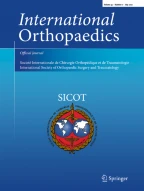Abstract
Ponseti’s and Kite’s methods of conservative management in idiopathic congenital clubfoot were compared in a prospective randomised study consisting of 45 infants (67 feet) younger than 3 months, from March 2003 through February 2004. There were 36 and 31 feet that underwent treatment by Ponseti’s and Kite’s methods, respectively. After an average follow-up of 27.24 months in the Ponseti group, correction was achieved in 33 feet (91.7%), with only three patients requiring surgical management. There were seven relapses (21.1%), all of which were corrected conservatively. However, two of these required surgical intervention on showing a relapse again in the second year. In the Kite group, we achieved correction in 21 feet (67.7%) after an average follow-up of 24.8 months, with ten patients requiring surgical intervention. There were eight relapses of which only four could be corrected conservatively. We could also achieve correction in very severe feet (Dimeglio classification) in a significantly higher percentage using Ponseti’s method, in significantly lesser time and with fewer casts. We are of the opinion that Ponseti’s method is superior to Kite’s method in achieving correction in idiopathic clubfeet in a relatively shorter period of time when used to treat young infants.
Résumé
Les méthodes de Ponseti et de Kite dans le traitement conservateur du pied bot congénital sont comparées dans une étude prospective randomisée incluant 45 enfants (67 pieds), traités avant 3 mois, étude réalisée de mars 2003 à février 2004. Trente-six pieds ont été traités selon la méthode de Ponseti et 31 selon la méthode de Kite. Le suivi moyen a été de 27.24 mois dans le groupe de Ponseti. La correction a été réalisée dans 33 pieds (91.7%), seulement 3 patients ont nécessité un traitement chirurgical. Il y a eu 7 récidives (21.1%), tous les pieds ont été traités avec un traitement conservateur. Cependant deux pieds nécessitant un traitement chirurgical ont montré une récidive dans la deuxième année. Dans le groupe Kite, la correction a été réalisée dans 21 pieds (67.7%) avec un suivi moyen de 24.8 mois, 10 patients ont nécessité un traitement chirurgical et 8 récidives dont 4 ont bénéficié d’un traitement conservateur. Nous pouvons traiter les pieds sévères (classification de Dimeglio) avec un bon pourcentage et bon résultat en utilisant la méthode de Ponseti qui permet de diminuer le temps de traitement et le nombre de plâtre. Nous pouvons conclure que la méthode de Ponseti est supérieure à la méthode de Kite, elle permet un temps de traitement plus court dans le traitement des pieds bots varus équins de l’enfant.
Similar content being viewed by others
References
Aronson J, Puskarich CL (1990) Deformities and disabilities from treated club foot. J Pediatr Orthop 10(1):109–119
Cooper DM, Dietz FR (1995) Treatment of idiopathic clubfoot-a 30-year follow-up note. J Bone Joint Surg 77-A(10):1477–1489
Cummings RJ (2002) Letter to editor. J Bone Joint Surg 84-A(10):1890
Demeglio A, Bensahel H, Sanchet P et al (1985) Classification of clubfoot. J Pediatr Orthop (B) 4:129–136
McKay DW (1982) New concept of approach to clubfoot treatment. Section 1-Principles and morbid anatomy. J Pediatr Orthop 2(4):347–356
Herzenberg JE, Radler C, Bor N (2002) Ponseti versus traditional method of casting for idiopathic club foot. J Pediatr Orthop 22(4):517–520
Ippolito E, Farsetti P, Caterini R, Tudisco C (2003) Long-term comparative results in patients with congenital clubfoot treated with two different protocols. J Bone Joint Surg 85 A(7):1286–1294
Herring JA (ed) ( 2002) Congenital talipes equinovarus (clubfoot) in Tachdjian’s paediatric orthopaedics, vol. 2, 3rd edn. Philadelphia, Saunders p 927
Kite JH (1935) The treatment of congenital clubfoot. Surg Gynaecol Obstet 61:190–200
Kite JH (1939) Principles involved in the treatment of congenital clubfoot. J Bone Joint Surg 21:595–606
Kite JH (1972) Non operative treatment of congenital clubfoot. Clin Orthop 84:29–38
Laaveg SJ, Ponseti IV (1980) Long-term results of treatment of congenital clubfoot. J Bone Joint Surg 62-A:23–31
Lehman WB, Mohaideen A, Madan S, Scher DM, Van Bosse HJ, Iannacone M, Bazzi JS, Feldman DS (2003) A method for the early evaluation of the Ponseti (Iowa) technique for treatment of idiopathic clubfoot. J Pediatr Orthop (B) 12:133–140
Morceunde JA, Dolan LA, Dietz FR, Ponseti IV (2004) Radical reduction in therate of extensive corrective surgery for clubfoot using the Ponseti method. Pediatrics 113:376–380
Morceunde JA, Abbasi D, LA Dolan, Ponseti IV (2005) Results of an accelerated Ponseti protocol for club foot. J Pediatr Orthop 25(5):623–626
Nather A, Bose K (1987) Conservative and surgical treatment of clubfoot. J Pediatr Orthop 7(1):42–48
Pirani S, Zeznik L, Hodges D (2001) MRI study of congenital clubfoot treated with Ponseti method. J Pediatr Orthop 21(6):719–726
Ponseti IV (1992) Current concept review. Treatment of congenital club foot. J Bone Joint Surg 74 A(3):448–454
Ponseti IV (1996) Treatment. Congenital clubfoot-fundamentals of treatment. New York; Oxford University Press pp 61–81
Ponseti IV (1997) Common Errors in the treatment of congenital clubfoot. Current Concepts, Int Orthop (SICOT) 21:137–141
Ponseti IV (2000) Editorial club foot. J Pediatr Orthop 20(6):699–700
Scher DM (2006) The Ponseti method of treatment of clubfoot. Curr Opin Pediatr 18(1):22–28
Segev E, Keret D, Lokiec F, Yavor A, Wientroub S, Ezra E, Havek S (2005) Early experience with the Ponseti method for treatment of congenital idiopathic club foot. Isr Med Associ J 7(5):307–310
Author information
Authors and Affiliations
Corresponding author
Additional information
The authors are grateful to Dr. Chandrakant Lahariya for his contribution in statistical analysis of the study.
Rights and permissions
About this article
Cite this article
Sud, A., Tiwari, A., Sharma, D. et al. Ponseti’s vs. Kite’s method in the treatment of clubfoot-a prospective randomised study. International Orthopaedics (SICO 32, 409–413 (2008). https://doi.org/10.1007/s00264-007-0332-y
Received:
Revised:
Accepted:
Published:
Issue Date:
DOI: https://doi.org/10.1007/s00264-007-0332-y
